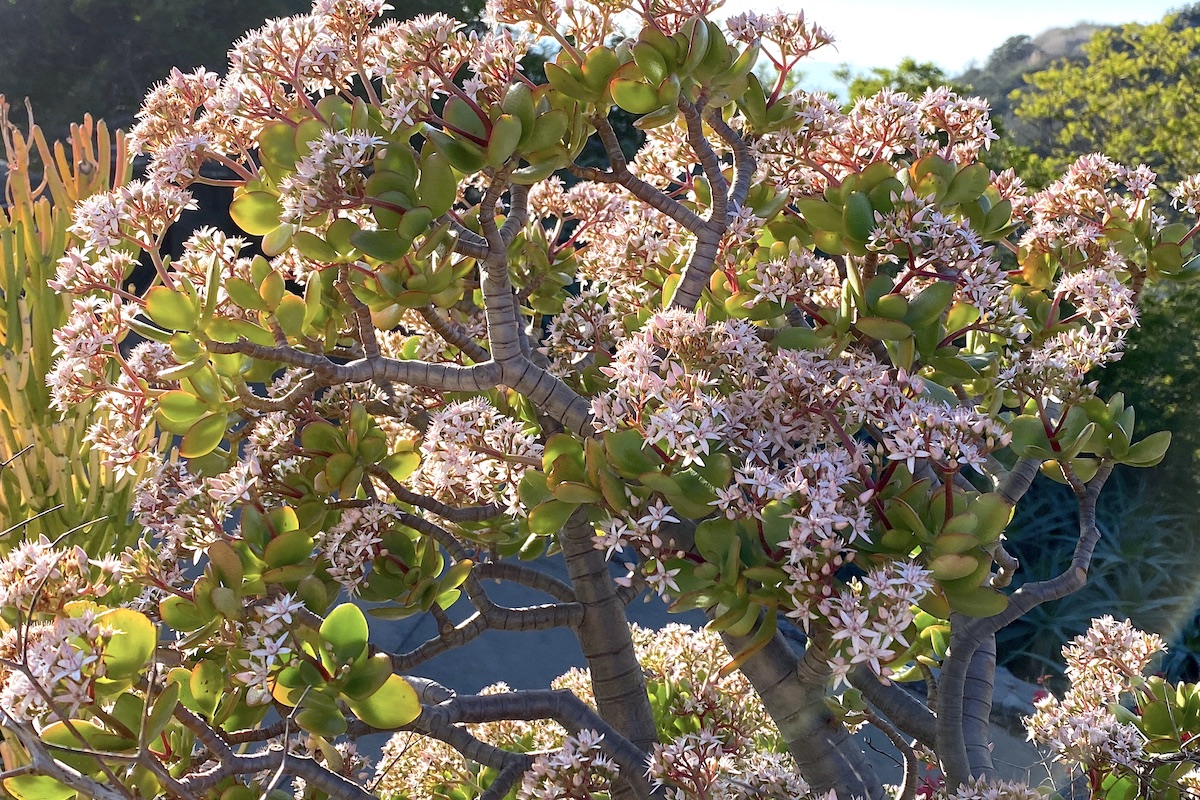
How and Why Jades Prune Themselves
If you've grown jade for ages but never noticed its self-pruning ability, you may not have known it was happening. Jades aren't like wet dogs that shake themselves, sending cuttings flying. It's a glacially slow process. Here I show it, and how to harvest cuttings specially selected by the parent plant itself.
Jades---Crassula ovata and its cultivars---are trouble-free, easy to come by, and form good-looking, mounded shrubs with open branching structures. Remarkably, the plants keep themselves thinned out, sometimes to the point they resemble bonsais: canopies of oval leaves atop thick, branching trunks.
Why grow jades?
Their ability to groom themselves makes jades arguably the most easy-care of succulents They're also a wonderfully low-water, visual asset to any garden. Colorful jades when small are good flowerbed-fillers; larger specimens serve well as hedges and backdrop plants.

Cuttings of several types of jades. Bands on their stems indicate where leaves once were attached and new roots will form.
These near-perfect succulents receive "no respect" because they're so common. Yet (ironically) they're ubiquitous because they're nearly perfect!
My only problem with jades is they can't handle temps below 32 degrees F. My garden gets frost every winter, but I do grow a half-dozen varieties in a linear microclimate along an east-facing wall that absorbs heat from the sun and is sheltered by eaves and lacy trees.
Why do jades self-prune?
All shrubs benefit from air circulation that keeps leaves clean and hinders pests from settling in. (If there's a pest that bothers jade, I'm unaware of it.) Moreover, sunlight entering the plant's center enables otherwise-shaded leaves to photosynthesize.
Fallen cuttings that result from self-pruning take root, thereby propagating the plant. When you see these, grab them; their prospects for successful growth are excellent.
What to watch for --
1. A stem pointing downward
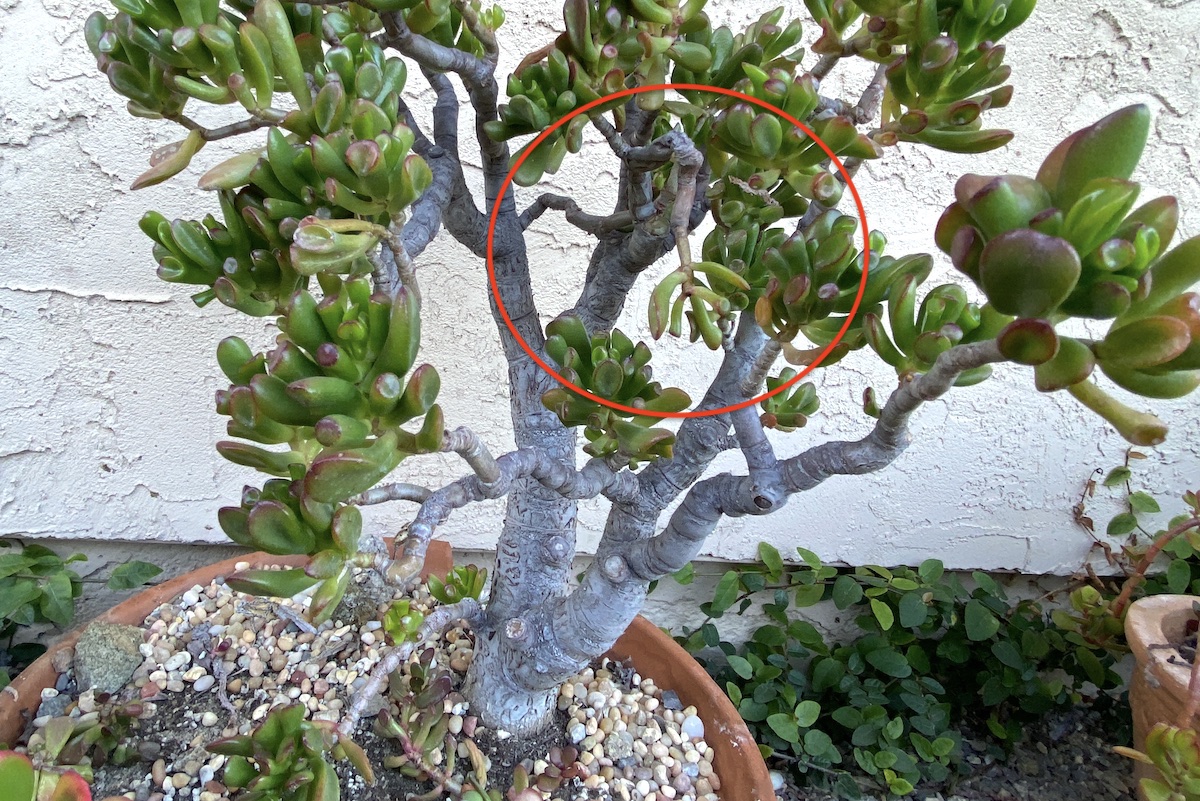
Stem beginning to wither
The self-pruning process starts with a pencil-thick stem that begins to wither where it's attached to the trunk. As it shrinks and dries, leaves at the cutting's tip get smaller because they're no longer nourished by the mother ship. They're feeding off their own reserves...which BTW, is the very definition of a succulent: A plant that lives off moisture in its tissues in order to survive periods of drought.
2. The cutting falls off
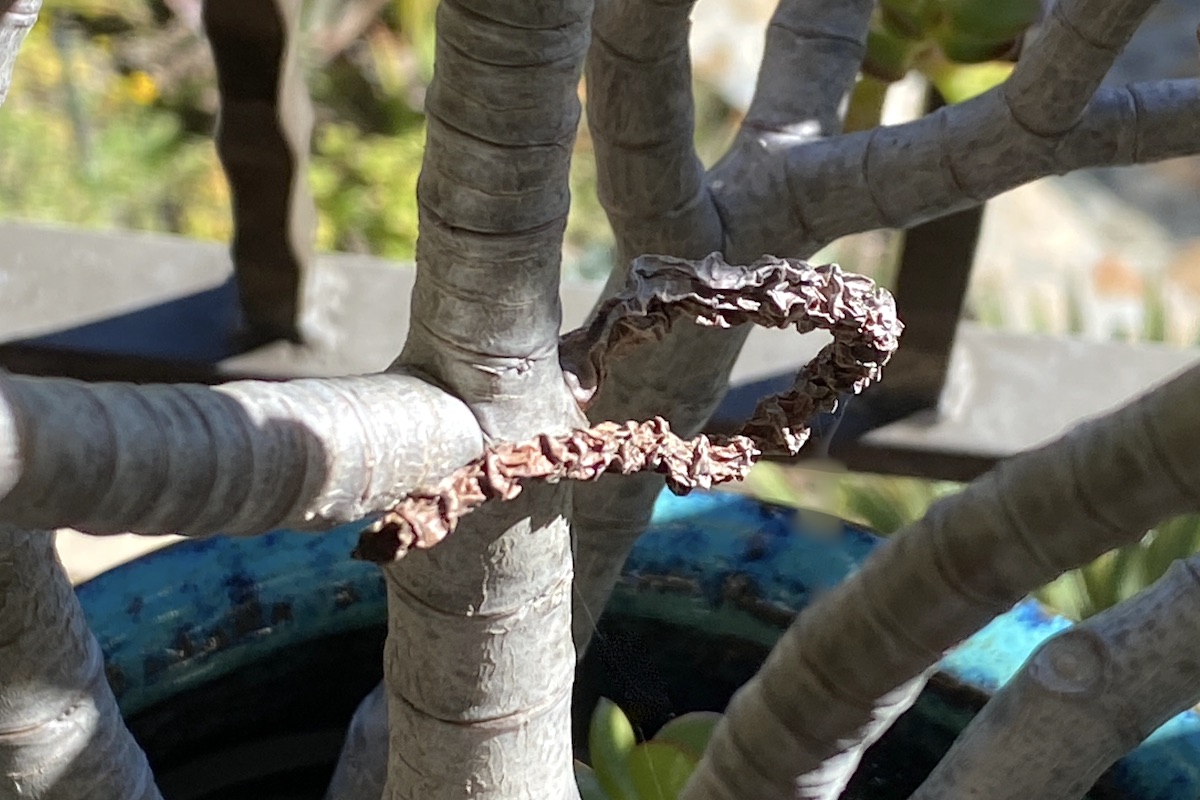
Withered stem on a potted jade
When the cutting drops to the ground, it may take its umbilicus with it, or leave it behind still attached to Mom. When I first noticed withered stems on my jades, I wondered if they were diseased. After a while, I realized the plants had the ability to self-prune! They weren't sick but smart!
3. Roots form
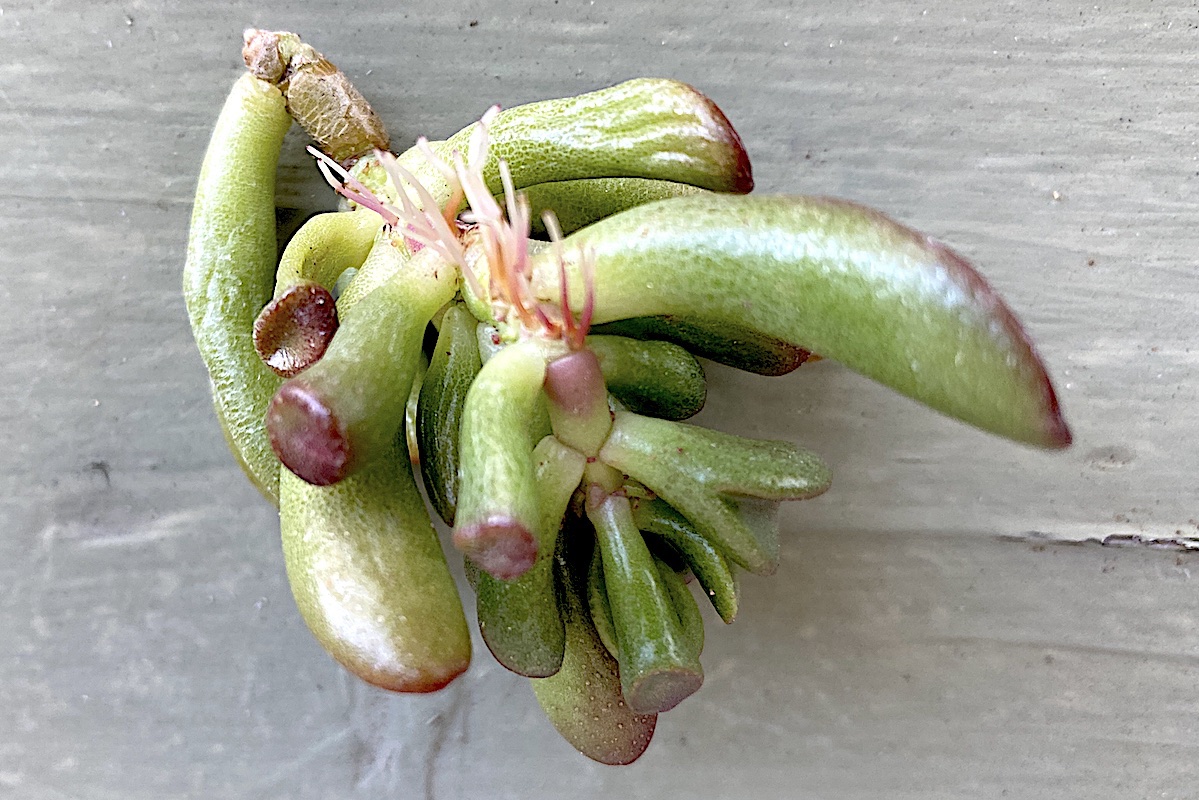
'Gollum' jade cutting with newly formed roots
Once on the ground, the cutting curls. Tip leaves and stem end point upward. Where the rest of the C-shaped cutting sits on the soil, it produces roots. (I show the cutting in the photo upside-down so you can see them.)
To avoid sun-scorch and desiccation, new plants need roots ASAP to pump moisture and nutrients back into them. This takes awhile---a week or more---during which the cutting lives off its lowest leaves. It often happens in late winter and early spring, when little jades will benefit from rain-soaked soil and cool weather.
4. Lots of baby plants
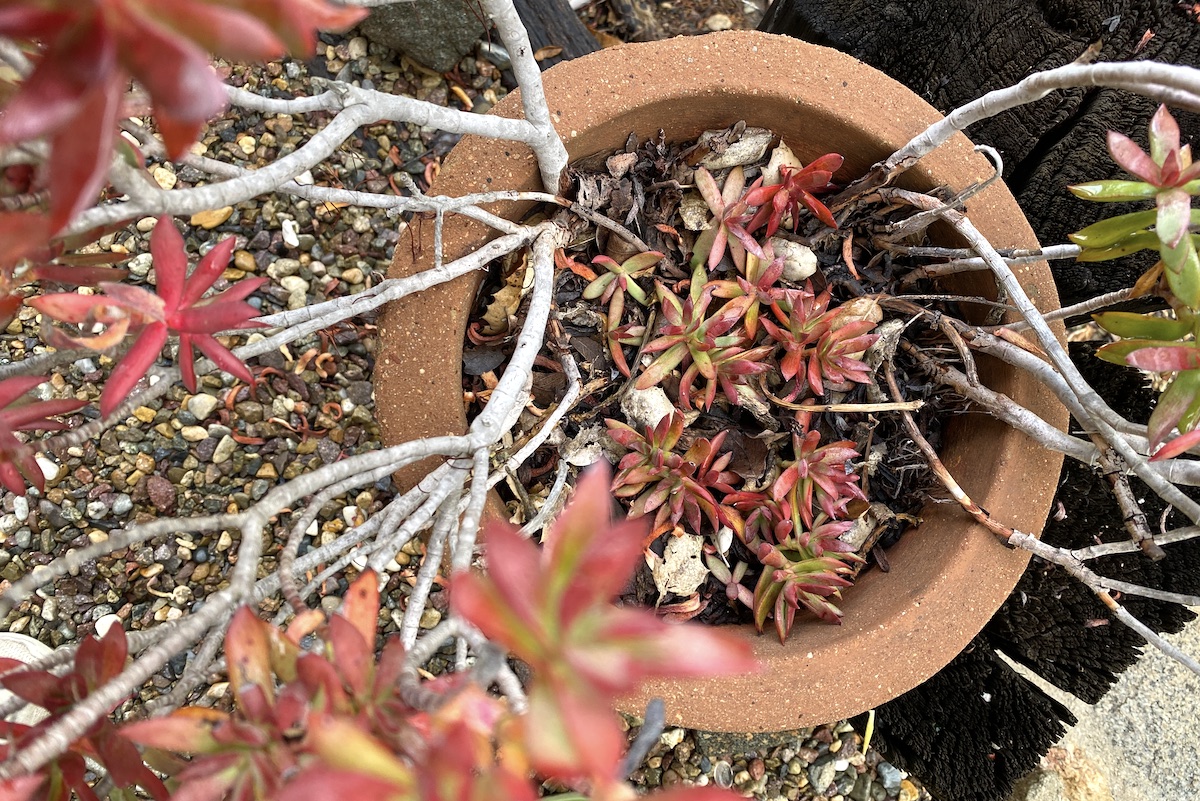
Crassula platyphylla illustrates that ovata is not the only Crassula species that self-prunes.
Fresh cuttings are green. Older ones---due to stress---turn red. They also shrivel. Before cuttings anchor themselves is a good time to reposition them in the garden or to give them their own pot. Rather than let them crowd the parent plant, I tuck (or if lazy, toss) fallen offspring into garden gaps.

Cuttings below a self-pruning parent
Btw, I don't especially want a pot filled with one large jade with lots of itty-bitties at its base. It's an aesthetic decision, but I prefer my jades to be solo stars in their pots.
What's going on here?

Crassula ovata ('Gollum' jade); circles indicate pruning
In this photo, the stem at upper left (red circle) is starting to wither. The blue circle shows a scar from where a stem previously fell off. The pink circle is where I took a cutting a year or so earlier. Doing so caused the stem to branch at the cut end ("bifurcate").
Note bands of tissue along the trunk and stems; they're where new roots will form should the plant be cut apart and planted as cuttings.
Maybe they simply broke off?
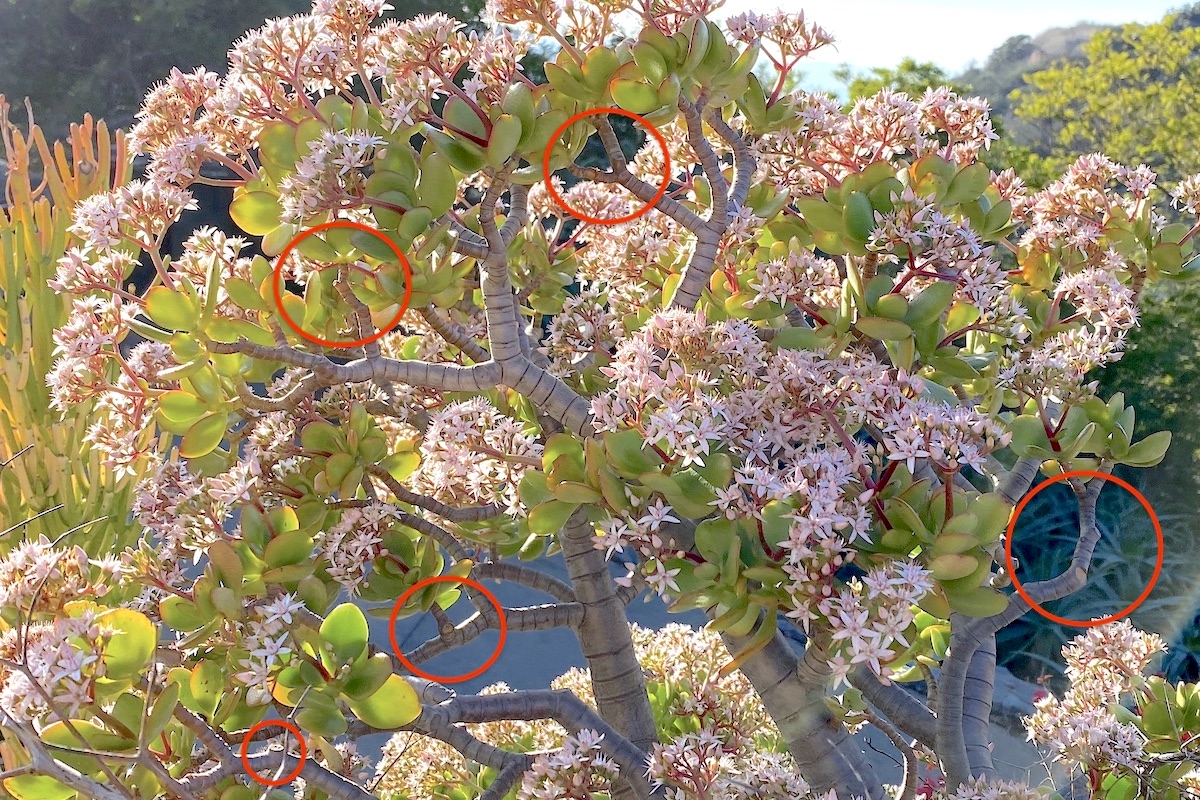
Circles indicate scars from missing stems
Here I've circled stem scars that resulted either from self-pruning or breakage. Jade is easy to take cuttings from---simply cut or snap off. Breakage also can result from impact, as when a child or wheelbarrow plows into the plant. That said, jades are not brittle and stems do have some flexibility.
Can you help?
I'm mystified as to why jades in pots tend to prune themselves more than those in the ground. Possibly a pot offers too little soil, so the plant dwarfs itself like a goldfish confined to a small bowl. But that doesn't explain why jades eventually get so large in pots they may become top-heavy and fall over.
If you have an observation or question, do share it in a comment below. Thanks!
Related info on this site
Crassula (Jade and More): Details, Photos and Varieties
Crassulas are among the easiest, most trouble-free succulents to grow, with one caveat: With few exceptions, they’re frost-tender (tend to be damaged when temperatures drop below 32 degrees F). Shrub varieties are very easy to start from cuttings, and stacked jades will send forth whiskery roots from between their tight leaves—simply snip off the stem and bury in potting soil so that roots are covered (it’s OK to bury a few leaves too). Crassulas, like aloes, also stress beautifully to shades of red, yellow and orange. Give variegated varieties adequate sun or they’ll revert to solid green.

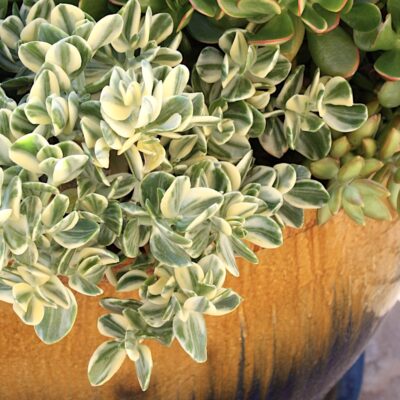
As a southern Californian, I’ve always kind of “turned my nose up” at this ubiquitous succulent, but when they are blooming, like now, they are beautiful and popular with bees too. I had no idea they self-pruned. Very interesting, thank you for this and all the knowledge you share.
You’re not alone! I’ve never understood why a homeowner would remove a 50-year-old jade plant just because it’s “common.” Have you seen my video, “Debra Defends Jade Plant”? It’s from a live presentation I gave in which I dis my ex for doing exactly that. (I’ve forgiven him for everything else.)
Thank You for all of the information you put forward to your reader. I always follow your messages
That means a lot to me, Diane. Thank you!
I received a foot tall jade cutting with side branches. I love that I can start big, but wondering if it’s too large to expect successful rooting & growth. Should I chop it up to smaller pieces, & how small should they be? Also, should I wait till baby roots appear before potting up & watering? Thanks, Debra!
Yes, you can start a foot-tall jade cutting. The important thing is that the cut end has callused (formed a thin membrane so it’s no longer juicy, takes a day or two), and that a band of tissue around the lowest part of the trunk is below the soil line—that’s where roots will grow. As for watering it, just keep the soil moist. That’s all it wants, really. Btw, I’ve done this often—planted cuttings 12 to 18 inches tall—and at first they droop, but in a few weeks or so, new roots are able to plump them back up.
Thank you for this helpful information about jade plants. I have several, one in a pot, the rest in the ground,
and I enjoy them all.
Hi Lois, you’re welcome! I’m glad you found it helpful. As long as you keep them above freezing, they’re bulletproof.
We had a huge jade plant once in a pot when we lived in northern California. As we were getting ready to move, I knew we could not take it in the moving van (they didn’t allow live flowers to be moved from northern California to Utah) and we couldn’t fit it in our car, so one of our neighbors came and took it away. I told her that if she could LIFT it, it was hers! Well, a tiny piece broke off in the effort of moving that monster out of our back patio and I popped it into some dirt. It grew so quickly. All I did was pop it into a small planter in some dirt and gave it some water. We now have it growing in our current home here in San Diego. lol Gotta love jade plants.
Hi Renee — Great story! The monster lives! It’s a good thing jades aren’t invasive, because they’d form a dense thicket all along the coast clear into Mexico.
I don’t know, but I’m jealous because I’m in Wisconsin and my Jades are growing on a windowsill and never bloom! Your Jades are beautiful. I have one Jade who self-pruned a branch but my others never have.
Hi Candy — Long before I was into succulents, I was amazed to see jade plants as prized specimens in greenhouses and conservatories in the East. I thought…you’re kidding! One person’s trash plant is another’s treasure.
Brilliant! I’ve also noticed my potted crassulas self-prune at a higher rate! Maybe it’s because limbs don’t get physically knocked off as often. Could it be regulating its own rate of propagation?
I dunno…maybe roots confined in a small space signal the plant to break apart?
In Illinois we have to bring our potted succulent collections inside for the winter. Mine are in a 16x 20 ft. heated porch with full windows on three sides in tray-topped custom cabinets. They are kept at 50 degrees with minimal water and I have found that every winter the variegated green and white jades, somewhat away from direct sun, are the ones that self prune and I always save and root the cuttings.
Good to know, Donald! They sound like happy jades, doing their thing despite being a very long distance from their native South Africa.
We have jades next to a south facing wall that receives direct summer sun in Upland, CA. They are never watered, except by rain. They struggle by the end of summer–and self-prune!–but look great the rest of the year.
And this is why we love them. There’s a jade I walk past in my neighborhood that gets no irrigation at all and is in full sun most of the day. By October, leaves are deeply wrinkled from being drained to keep the plant alive. Winter rainfall revives it, and you’d never know it had been under any stress. Hm. I just realized I should pour a bottle of water at its base every so often in summer. It’s near the curb—no one would notice. After all, I water my next-door neighbor’s orange tree occasionally in summer to keep it alive…why not a succulent?
I have had a Hummel Sunset and a Bluebird in separate pots for over 20 years and they are now giant bonsais! The Sunset was actually getting a bit leggy and I lightly pruned it one spring and repotted it. It loved it! And yes occasionally they drop small pieces which I use for cuttings. I have to keep them under the verandah during winter or they get frosted.
Central Victoria, Australia
Hi Melanie — How marvelous to get validation from the other side of the planet. Thank you so much for sharing!
Hi Debra,
The jade plant is one of my favorite bonsai candidates because it has the following characteristics: a tapering trunk line; an abundance of branches reaching out in all directions; a tree-like appearance as natural looking as possible with reference to its species. What’s missing though is a good spread of roots emerging from the base at the level of the soil disappearing into the soil to denote stability and agedness; this is why I grow my jade bonsais in short round clay pots.
My oldest and favorite bonsai jade crassula ovata plant is at least 25 years old (possibly 30 years old) with a 4-inch diameter trunk tapering upward to a maximum 18-inch height with 4 main staggered branches extending outward, contained in a low 6-inch high, 8-inch diameter wide clay pot. This plant in a pot weighs only 15 pounds. This year-round outdoor plant in Los Angeles County is the epitome of very low easy maintenance, self pruning, drought resistant, and dwarf growth. I don’t pluck off dying leaves; I allow leaves to shrivel up, die and drop naturally). The branching pattern of this plant has alway been outward and upward (rarely if at all downward). Also, a clear advantage of a potted plant is that it can be rotated to promote an overall even rounded growth. All my succulents are potted and grown outdoors. Since photos cannot be posted here in my reply, I emailed you a couple photos of my bonsai jade tree-like plant.
Bottom-line: all of my bonsai jade plant’s characteristics is attributable and controlled primarily to its small clay pot container. Whenever the pot cracks or breaks, I always replant this jade in the same size pot. I have two other bonsai jades (20 and 10 years old) in smaller 6-inch diameter wide clay pots, exhibiting the same characteristics.
I also have growing 3 Crassula ovata variegata/tricolor bonsai plants in very early stages of growth in smaller clay pots. These jade tricolor plants (like their same larger mother plant) however are showing far more aggressive rapid growth patterns.
I for one do not find jade plants boring at all, and these plants do not deserve a Rodney Dangerfield “No respect” tag.
Hi Ray — Thank you for sharing your success with jade and helping to give the plants the positive recognition they deserve. You described yours in such a way that anyone might feel they could do the same. I can attest that 25 years passes in no time, and all the while, my jade plants have quietly behaved themselves, looking great year-round but especially in winter. Once a decade or so, a potted one gets top-heavy and keels over. My bad.